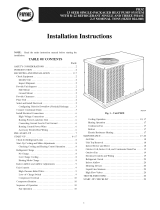
Installation & Start-up
PY1P, PY2P
Single Packaged Gas Heating/
Electric Cooling Units
Instructions
NOTE: Read the entire instruction manual before starting the insta]lation.
TABLE OF CONTENTS
SAFETY CONSIDERATIONS ..................................................................................................................................................................................... 2
INTRODUCTION .......................................................................................................................................................................................................... 3
RECEIVING AND INSTALLATION .......................................................................................................................................................................... 3
CHECK EQUIPMENT ............................................................................................................................................................................................ 3
IDENTIFY UNIT ................................................................................................................................................................................................ 3
INSPECT SHIPMENT ........................................................................................................................................................................................ 3
INSTALLATION ................................................................................................................................................................................................ 3
PROVIDE UNIT SUPPORT ................................................................................................................................................................................... 3
ROOF CURB ...................................................................................................................................................................................................... 3
SLAB MOUNT ................................................................................................................................................................................................... 3
GROUND MOUNT ............................................................................................................................................................................................ 3
FIELD FABRICATE DUCTWORK ....................................................................................................................................................................... 3
PROVIDE CLEARANCES ...................................................................................................................................................................................... 6
RIG AND PLACE UNIT ......................................................................................................................................................................................... 8
CONNECT CONDENSATE DRAIN ...................................................................................................................................................................... 8
INSTALL FLUE HOOD .......................................................................................................................................................................................... 8
INSTALL GAS PIPING .......................................................................................................................................................................................... 9
INSTALL DUCT CONNECTIONS ...................................................................................................................................................................... 12
CONFIGURING UNITS FOR DOWNFLOW (VERTICAL) DISCHARGE ................................................................................................ 12
INSTALL ELECTRICAL CONNECTIONS ........................................................................................................................................................ 14
HIGH-VOLTAGE CONNECTIONS ............................................................................................................................................................... 14
SPECIAL PROCEDURES FOR 208-V OPERATION ................................................................................................................................... 15
CONTROL VOLTAGE CONNECTIONS ...................................................................................................................................................... 15
HEAT ANTICIPATOR SE'FflNG .................................................................................................................................................................. 15
TRANSFORMER PROTECTION ................................................................................................................................................................... 15
PRE-START-UP .......................................................................................................................................................................................................... 16
START-UP ................................................................................................................................................................................................................... 18
CHECK FOR REFRIGERANT LEAKS ............................................................................................................................................................... 18
START-UP HEATING AND MAKE ADJUSTMENTS ..................................................................................................................................... 18
CHECK HEATING CONTROL ...................................................................................................................................................................... 18
CHECK GAS INPUT ....................................................................................................................................................................................... 22
ADJUST GAS INPUT ...................................................................................................................................................................................... 22
CHECK BURNER FLAME ............................................................................................................................................................................. 23
AIRFLOW AND TEMPERATURE RISE ...................................................................................................................................................... 23
HEATING SEQUENCE OF OPERATION ..................................................................................................................................................... 23
LIMIT SWITCHES ........................................................................................................................................................................................... 23
AUXILIARY LIMFF SWITCH (ROLLOUT) ................................................................................................................................................. 24
START-UP COOLING AND MAKE ADJUSTMENTS ..................................................................................................................................... 24
CHECKING COOLING CONTROL OPERATION ....................................................................................................................................... 24
CHECKING AND ADJUSTING REFRIGERANT CHARGE ...................................................................................................................... 24
INDOOR AIRFLOW AND AIRFLOW ADJUSTMENTS ............................................................................................................................. 25
COOLING SEQUENCE OF OPERATION .................................................................................................................................................... 25
MAINTENANCE ........................................................................................................................................................................................................ 26
AIR FILTER ..................................................................................................................................................................................................... 28
EVAPORATOR BLOWER AND MOTOR .................................................................................................................................................... 28
FLUE GAS PASSAGEWAYS ......................................................................................................................................................................... 30
COMBUSTION-AIR BLOWER ...................................................................................................................................................................... 30
LIMIT SWITCH ............................................................................................................................................................................................... 31
BURNER IGNITION ........................................................................................................................................................................................ 31
Form: IM-PY1P-03 Cancels: IM-PY1P-02 Printed in U.S.A. 11-02 Catalog No. 53PY-1P15



























